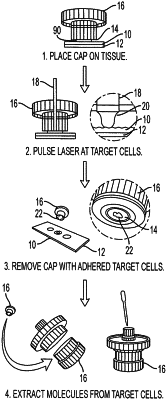| CPC G01N 1/2813 (2013.01) [G01B 11/002 (2013.01); G01N 2001/282 (2013.01); G01N 2001/284 (2013.01); Y10T 156/10 (2015.01); Y10T 156/1054 (2015.01)] | 16 Claims |

|
1. A method for processing a biological sample using a laser microdissection instrument, comprising:
calibrating a capture laser to determine an optimal setting for wetting a transfer film mounted on a cap, said calibration comprising:
firing the capture laser at a selected test fire location on the cap;
recording intensity data of a test image at the selected test fire location; and
determining whether wetting of the transfer film at the selected location is optimal based on detecting a maximum intensity difference between adjacent pixels;
bringing the transfer film into juxtaposition with a targeted portion of biological material on a substrate;
directing the capture laser to fire at the targeted portion of biological material to form an area of adhesion between a wetted portion of the transfer film and the targeted portion of biological material; and
moving the cap away from the substrate, thereby removing the targeted portion of biological material with the cap.
|